SAT (Scholastic Assessment Test) is a standard test, used for taking admission to undergraduate programs of universities or colleges of the United States. SAT is developed and published by the College Board, an organization in the United States, administered by the Educational Testing Service. In this article of AKVTutorials, you will get SAT Reading Section Practice Test 43 | SAT 2024 Online Tutor AMBiPi.
SAT Reading Practice Passage
This passage is adapted from Marlene Zuk, Paleofantasy: What Evolution Tells Us about Sex, Diet, and How We Live. ©2013 by Marlene Zuk.
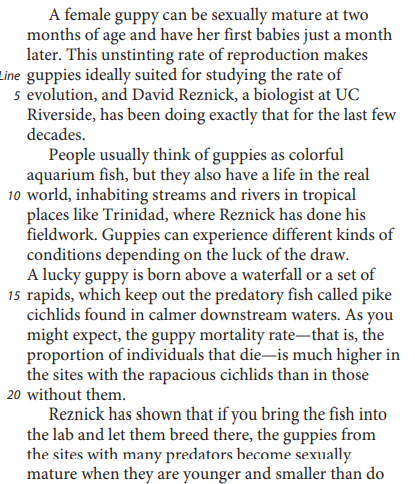
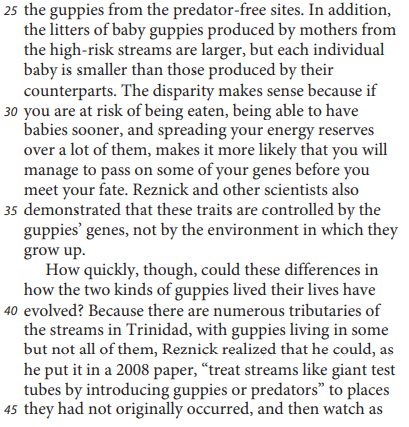
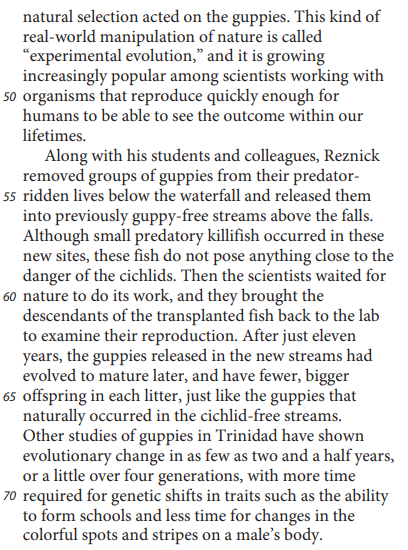
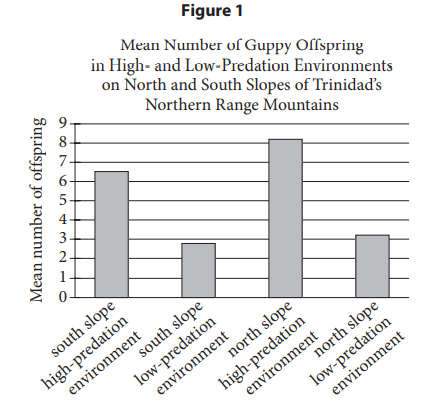
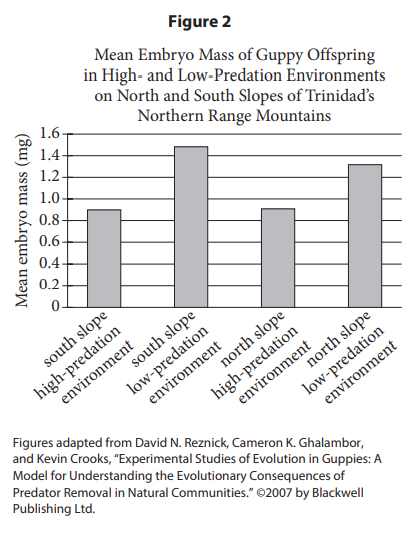
SAT Reading Comprehension Practice Test Questions
SAT Practice Test 43 Question No 1
The first paragraph mainly serves to
Option A: establish the reason why a certain species was selected for scientific observation.
Option B: illustrate the value of studying the offspring of a particular animal shortly after birth.
Option C: introduce a theory at the center of an ongoing scientific debate.
Option D: offer a rationale for the prevalence of a new field of scientific inquiry.
SAT Practice Test 43 Answer No 1
Show/Hide Answer
Option A :
Throughout the passage, the author describes experiments conducted on guppies to determine the guppies’ rate of and types of evolutionary change. The first paragraph outlines the reason why these fish were an optimal choice for this research: their “unstinting rate of reproduction makes guppies ideally suited for studying the rate of evolution.” Therefore, the first paragraph mainly serves to establish the reason why a certain species was selected for scientific observation.
Choice B is incorrect because the purpose of the first paragraph isn’t to illustrate the value of studying the offspring of a particular animal shortly after birth. Instead, guppies were selected because of their rapid rate of reproduction and weren’t only studied shortly after being born, according to the passage. Choices C and D are incorrect. Although the fourth paragraph does introduce a new method of scientific inquiry (experimental evolution), the first paragraph doesn’t mainly serve to introduce a theory at the center of an ongoing scientific debate (choice C) or offer a rationale for the prevalence of a new field of scientific inquiry (choice D).
SAT Practice Test 43 Question No 2
In describing the living conditions of guppies, the author indicates that a “lucky guppy” (line 14) is one that
Option A: is born in a major river having an established guppy population.
Option B: inhabits an environment that provides natural protection from predators.
Option C: manages to navigate the risks associated with living near a waterfall.
Option D: avoid predatory fish by living in calmer downstream waters.
SAT Practice Test 43 Answer No 2
Show/Hide Answer
Option B :
The third sentence of the second paragraph states, “A lucky guppy is born above a waterfall or a set of rapids, which keep out the predatory fish called pike cichlids found in calmer downstream waters.” In other words, pike cichlids normally eat guppies, but waterfalls and rapids can create natural barriers that prevent these predators from entering certain areas where guppies live. Thus, in describing the living conditions of guppies, the author indicates that a “lucky guppy” inhabits an environment that provides natural protection from predators.
Choices A and C are incorrect because the author doesn’t indicate that being born in a major river with an established guppy population is an advantage for a guppy (choice A) or that there are risks associated with living near a waterfall or that guppies benefit by avoiding such risks (choice C). Choice D is incorrect because the author doesn’t indicate that there is an advantage for guppies living in calmer downstream waters. Instead, the author notes that calmer downstream waters are where guppies’ predators live, making these zones more dangerous for guppies than the areas above waterfalls or rapids.
SAT Practice Test 43 Question No 3
Which choice provides the best evidence for the conclusion that the streams used by Reznick’s team in their real-world study were not entirely free of predators?
Option A: Lines 14-16 (“A lucky… waters”)
Option B: Lines 16-20 (“As you… them”)
Option C: Lines 46-52 (“This… lifetimes”)
Option D: Lines 57-59 (“Although… cichlids”)
SAT Practice Test 43 Answer No 3
Show/Hide Answer
Option D :
In the last paragraph, the author describes an experiment in which Reznick’s team removed groups of guppies from areas with large populations of pike cichlid predators and relocated them into areas above waterfalls and rapids. According to the second sentence of this paragraph, “Although small predatory killifish occurred in these new sites, these fish do not pose anything close to the danger of the cichlids.” This sentence provides the best evidence for the conclusion that the streams used by Reznick’s team were not entirely free of predators, as they contained populations of killifish.
Choices A, B, and C are incorrect because the cited lines don’t provide the best evidence for the conclusion that the streams used by Reznick’s team were not entirely free of predators. Instead, they explain the advantage for guppies living above waterfalls or rapids (choice A), outline the correlation between numbers of pike cichlids and guppy mortality rates (choice B), and explain the growing popularity of “experimental evolution” among scientists (choice C).
SAT Practice Test 43 Question No 4
In lines 43-44, Reznick uses the phrase “giant test tubes” to suggest that certain streams can
Option A: provide suitable experimental conditions.
Option B: promote cooperative behaviors in specimens.
Option C: expedite the rate of genetic changes.
Option D: solve widespread environmental problems.
SAT Practice Test 43 Answer No 4
Show/Hide Answer
Option A :
According to the fourth paragraph, the existence of streams in Trinidad with populations of guppies and those without guppies led Reznick to the conclusion that he could conduct experiments by altering the guppy populations in various streams. According to the second sentence of the fourth paragraph, Reznick realized he could “‘treat streams like giant test tubes by introducing guppies or predators’ to places they had not originally occurred, and then watch as natural selection acted on the guppies.” Reznick uses the phrase “giant test tubes” in this sentence to suggest that certain streams can provide suitable experimental conditions for his guppy research.
Choices B, C, and D are incorrect because the phrase “giant test tubes” serves to characterize certain streams as suitable for experimental research, not to suggest that those streams promote cooperative behaviors among guppies used as subjects in experimental studies (choice B), increase the rate of genetic change among guppies (choice C), or assist scientists in solving environmental problems in the natural habitat of guppies (choice D).
SAT Practice Test 43 Question No 5
As used in line 49, “popular” most nearly means
Option A: accessible.
Option B: suitable.
Option C: widespread.
Option D: likable.
SAT Practice Test 43 Answer No 5
Show/Hide Answer
Option C :
The fourth paragraph describes Reznick’s rationale for moving populations of guppies from one body of water to another. The last sentence of the paragraph states, “This kind of real-world manipulation of nature is called ‘experimental evolution,’ and it is growing increasingly popular among scientists working with organisms that reproduce quickly enough for humans to be able to see the outcome within our lifetimes.” In other words, the fact that this type of research is “growing increasingly popular” means that it is becoming more widespread. Thus, the word “popular” as used in the passage most nearly means widespread.
Choices A, B, and D are incorrect because in the context of the passage, “popular” means widespread, not accessible (choice A), suitable (choice B), or likable (choice D).
SAT Practice Test 43 Question No 6
Which finding, if accurate, would undermine Reznick’s findings?
Option A: Guppies examined in other parts of the globe exhibit genetic shifts in traits at a different rate from those exhibited by the guppies Reznick examined.
Option B: The new site into which Reznick released the guppies is inhabited by fish that are found to be as predatory as the cichlids in the original sites.
Option C: Experimental evolution is shown to be harmful to the environments where studies like Reznick’s are conducted.
Option D: The descendants of Reznick’s transplanted fish are proven to mature later than the guppies living below the waterfall.
SAT Practice Test 43 Answer No 6
Show/Hide Answer
Option B :
Reznick’s team found that guppies, when moved from predator-ridden environments to a site where there was not the same level of predation, “evolved to mature later, and have fewer, bigger offspring in each litter, just like the guppies that naturally occurred in the cichlid-free streams,” according to the fourth sentence of the last paragraph. If it were discovered that the new site into which Reznick released the guppies were inhabited by fish found to be as predatory as the cichlids in the original sites, this discovery would undermine Reznick’s findings. Such a finding would mean that the pressure of predation on the guppies remained constant from one site to the next. As a consequence, some other factor or factors would be responsible for the developmental changes in the guppies that Reznick’s team recorded.
Choice A is incorrect. If guppies are examined in other parts of the globe were found to exhibit genetic shifts in traits at a different rate from the guppies Reznick examined, these findings would not undermine his research because they would have occurred outside the confines of his experimental conditions. Choice C is incorrect. If experimental evolution was shown to be harmful to the environment, this finding, though important, would not undermine Reznick’s findings. Choice D is incorrect. If the descendants of Reznick’s transplanted fish were proven to mature later than the guppies living below the waterfall, this finding would support, rather than undermine, Reznick’s findings.
SAT Practice Test 43 Question No 7
It can most reasonably be inferred from the passage that the experiments in Trinidad have shown which of the following about guppies?
Option A: Some genetic traits will evolve more readily than others.
Option B: Some predatory fish are more dangerous to guppies than cichlids are.
Option C: Some guppies thrive better in areas below waterfalls than they do in areas above waterfalls.
Option D: Some genetic shifts are easier to prevent in a natural environment than in a lab.
SAT Practice Test 43 Answer No 7
Show/Hide Answer
Option A :
The last sentence of the passage states, “Other studies of guppies in Trinidad have shown an evolutionary change in as few as two and a half years, or a little over four generations, with more time required for genetic shifts in traits such as the ability to form schools and less time for changes in the colorful spots and stripes on a male’s body.” That is, certain traits, such as physical markings, seem to change more quickly than other traits, such as aspects of group behavior. Thus, it can most reasonably be inferred from the passage that the experiments in Trinidad have shown that some genetic traits will evolve more readily than others.
Choices B, C, and D are incorrect because the experiments in Trinidad led to conclusions about guppies’ rate of evolutionary changes. These experiments did not lead to an identification of other dangerous predators (choice B), an analysis of how certain guppies thrive better in predator-ridden environments (choice C), or an examination as to how evolutionary changes can be prevented in a natural environment (choice D).
SAT Practice Test 43 Question No 8
Which choice provides the best evidence for the answer to the previous question?
Option A: Lines 38-40 (“How quickly… evolved”)
Option B: Lines 40-46 (“Because…the guppies”)
Option C: Lines 53-56 (“Along… falls”)
Option D: Lines 67-72 (“Other… body”)
SAT Practice Test 43 Answer No 8
Show/Hide Answer
Option D :
The previous question asks what can most reasonably be inferred about guppies based on the experiments in Trinidad described in the passage. The answer, that some guppy genetic traits will evolve more readily than others, is best supported by the last sentence of the passage: “Other studies of guppies in Trinidad have shown an evolutionary change in as few as two and a half years, or a little over four generations, with more time required for genetic shifts in traits such as the ability to form schools and less time for changes in the colorful spots and stripes on a male’s body.”
Choices A, B, and C are incorrect because the cited lines don’t support the answer to the previous question. Instead, they pose a question central to Reznick’s research (choice A), describe the conditions that led Reznick to consider conducting experimental evolution tests in Trinidad (choice B) and describe how Reznick’s team removed guppies from one area and reintroduced them in another (choice C).
SAT Practice Test 43 Question No 9
According to figure 1, guppies living in the south slope high-predation environment produced a mean number of offspring between
Option A: 2 and 3.
Option B: 3 and 4.
Option C: 5 and 6.
Option D: 6 and 7.
SAT Practice Test 43 Answer No 9
Show/Hide Answer
Option D :
The number of offspring produced by guppies living in the south slope, high-predation environment is indicated by the first bar from the left in figure 1. This bar rises to a point midway between 6 and 7 on the graph. Therefore, according to figure 1, guppies living in the south slope high-predation environment produced a mean number of offspring between 6 and 7.
Choice A is incorrect because 2 to 3 offspring were produced by guppies living in the south slope low-predation environment, rather than those living in the high-predation environment, as indicated by the second bar from the left in figure 1. Choice B is incorrect because 3 to 4 offspring were produced by guppies living in the north slope low-predation environment, rather than guppies living in the south slope high-predation environment, as indicated by the bar that is farthest to the right in figure 1. Choice C is incorrect because none of the groups represented in figure 1 produced 5 to 6 offspring.
SAT Practice Test 43 Question No 10
Which conclusion about the mean mass of guppy embryos is best supported by figure 2?
Option A: The slope location was a better indicator of mean embryo mass than was the predation level observed in each environment.
Option B: The mean embryo mass of guppies born in the north slope environments exceeded the mean embryo mass of guppies born in the south slope environments.
Option C: The predation level observed in each environment had more of an effect on mean embryo mass than did slope location.
Option D: The guppies born in the low-predation environments had a mean embryo mass less than that of guppies born in the high-predation environments.
SAT Practice Test 43 Answer No 10
Show/Hide Answer
Option C :
The graph shows that the mean embryo mass in a low-predation environment for south slope guppies (second bar from the left) is higher than the mean embryo mass in a high-predation environment for south slope guppies (bar farthest to the left). A similar relationship exists for north slope guppies, as the mean embryo mass in a low-predation environment (bar farthest to the right) is higher than the mean embryo mass in a high-predation environment (third bar from the left). Meanwhile, a comparison of south slope high-predation environments (bar farthest to the left) to north slope high-predation environments shows no difference in mean embryo mass. The graph shows that while there is a slightly lower mean embryo mass in north slope low-predation environments (bar farthest to the right) than in south slope low-predation environments (second bar from the left), this difference is only 0.2 mg, which is considerably less than the difference that results from comparing the low- and high-predation environments in each of the two locations. Therefore, the conclusion about the mean mass of guppy embryos that is best supported by figure 2 is that the predation level observed in each environment had more of an effect on mean embryo mass than did slope location.
Choice A is incorrect because slope location wasn’t a better indicator of mean embryo mass than was the predation level observed in each environment. Instead, the mean masses of embryos in the two locations were roughly equivalent. Choice B is incorrect because the mean embryo mass of guppies born in the north slope environments didn’t exceed the mean embryo mass of guppies born in the south slope environments. Guppies living in high-predation environments in both north and south slope locations had embryos with the same mass, while those living on the north slope in low-predation environments had embryos with a slightly lower mass than that of south slope guppies in low-predation environments. Therefore, the mean embryo mass of guppies born in the south slope environment exceeded the mean embryo mass of guppies born in the north slope environment. Choice D is incorrect because guppies born in low-predation environments didn’t have a mean embryo mass less than that of guppies born in high-predation environments. Instead, these guppies had a greater mass.



